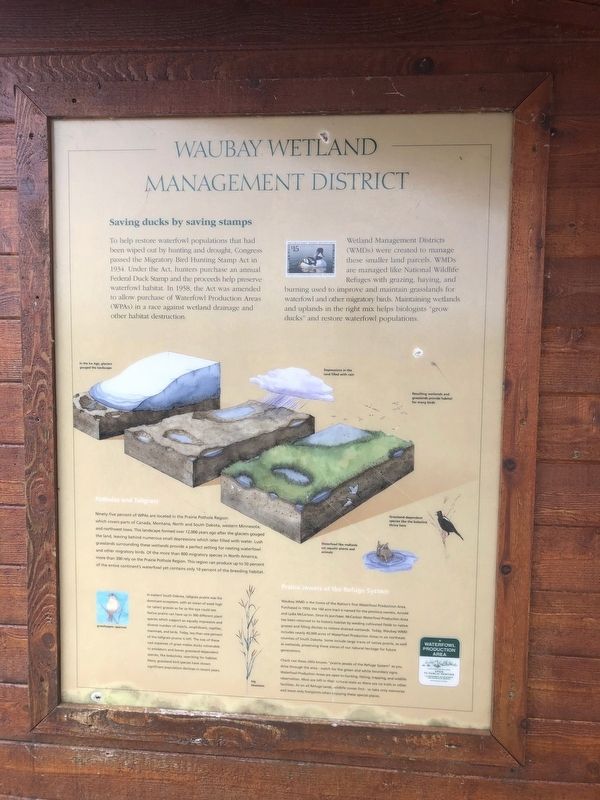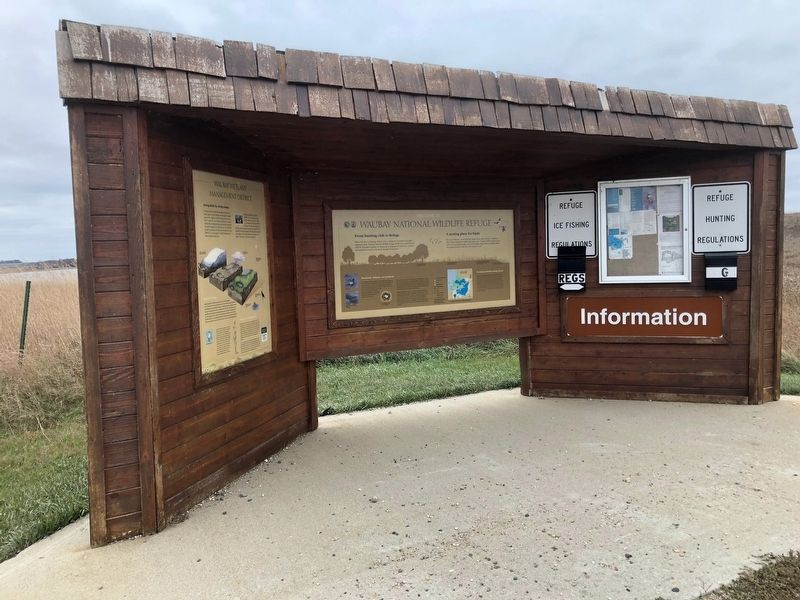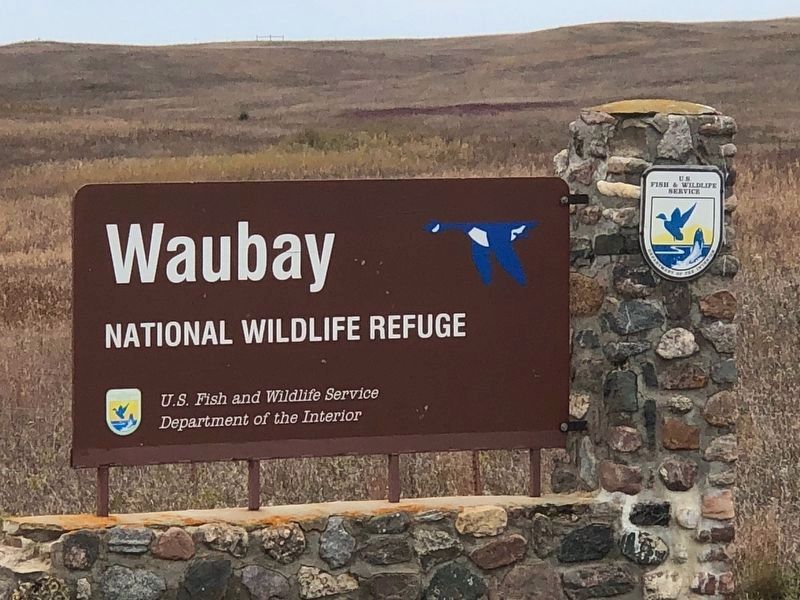Near Waubay in Day County, South Dakota — The American Midwest (Upper Plains)
Waubay Wetland Management District
Saving ducks by saving stamps
To help restore waterfowl populations that had been wiped out by hunting and drought, Congress passed the migratory Bird Hunting Stamp Act in 1934. Under the Act, hunters purchase an annual Federal Duck Stamp and the proceeds help preserve waterfowl habitat. In 1958, the Act was amended to allow purchase of Waterfowl Production Areas (WPAs) in a race against wetland drainage and other habitat destruction.
Wetland Management Districts (WMDs) were created to manage these smaller land parcels. WMDs are managed like National Wildlife Refuges with grazing, haying, and burning used to improve and maintain grasslands for waterfowl and other migratory birds. Maintaining wetlands and uplands in the right mix helps biologists "grow ducks" and restore waterfowl populations.
Potholes and Tallgrass
Ninety-five percent of WPAs are located in the Prairie Pothole Region which covers parts of Canada, Montana, North and South Dakota, western Minnesota, and northwest Iowa. This landscape formed over 12,000 years ago after the glaciers gouged the land, leaving behind numerous small depressions which later filled with water. Lush grasslands surrounding these wetlands provide a perfect setting for nesting waterfowl and other migratory birds. Of the more than 800 migratory species in North America, more than 300 rely on the Prairie Pothole Region. This region can produce up to 50 percent of the entire continent's waterfowl yet contains only 10 percent of the breeding habitat.
In eastern South Dakota, tallgrass prairie was the dominant ecosystem, with an ocean of waist high (or taller) grasses as far as the eye could see. Native prairie can have up to 300 different plant species which support an equally impressive and diverse number of insects, amphibians, reptiles, mammals, and birds. Today, less than one percent of the tallgrass prairie is left. The loss of these vast expanses of grass makes ducks vulnerable to predators and leaves grassland-dependent species, like bobolinks, searching for habitat. Many grassland bird species have shown significant population declines in recent years.
Prairie Jewels of the Refuge System
Waubay WMD is the move of the Nation's first Waterfowl Production Area. Purchased in 1959, the 160 acre tract is named for the previous owners, Arnold and Lydia McCarlson. Since its purchase, McCarlson Waterfowl Production Area has been returned to its historic habitat by seeding cultivated fields to native grasses and filling ditches to restore drained wetlands. Today, Waubay WMD includes nearly 40,000 acres of Waterfowl Production Areas in six northeast counties of South Dakota. Some include large tracts of native prairie, as well as wetlands, preserving these pieces of our natural heritage for future generations.
Check out these little known "prairie Jewels of the Refuge System" as you drive through the area - watch for the green and white boundary signs. Waterfowl Production Areas are open to hunting, fishing, trapping, and wildlife observation. Most are left in their natural state so there are not trails or other facilities. AS on all Refuge lands, wildlife comes first - so take only memories and leave only footprints when enjoying these special places.
Picture Captions
In the Ice Age glaciers gouged the landscape.
Depressions in the land filled with rain.
Resulting wetlands and grasslands provide habitat for many birds.
Waterfowl like mallards eat aquatic plants and animals.
Grassland-dependent species like the bobolink thrive here.
Topics. This historical marker is listed in these topic lists: Charity & Public Work • Environment. A significant historical year for this entry is 1934.
Location. 45° 25.887′ N, 97° 18.485′ W. Marker is near Waubay, South Dakota, in Day County. Marker is on Waubay Refuge Entrance Road. The marker is one half mile from the park entrance off 466th ave. Touch for map. Marker is in this post office area: Waubay SD 57273, United States of America. Touch for directions.
Other nearby markers. At least 8 other markers are within 8 miles of this marker, measured as the crow flies. Waubay National Wildlife Refuge (here, next to this marker); Changes on the Land (approx. 0.4 miles away); a different marker also named Waubay National Wildlife Refuge (approx. one mile away); Potholes and Prairie (approx. 1.1 miles away); Saving Men and Beasts (approx. 1.1 miles away); A Room with a View (approx. 1.1 miles away); Chief Bluedog (approx. 1.2 miles away); Roberts County / Day County South Dakota (approx. 7.9 miles away). Touch for a list and map of all markers in Waubay.
Credits. This page was last revised on November 1, 2018. It was originally submitted on October 23, 2018, by Ruth VanSteenwyk of Aberdeen, South Dakota. This page has been viewed 114 times since then and 14 times this year. Photos: 1, 2, 3. submitted on October 23, 2018, by Ruth VanSteenwyk of Aberdeen, South Dakota. • Andrew Ruppenstein was the editor who published this page.


